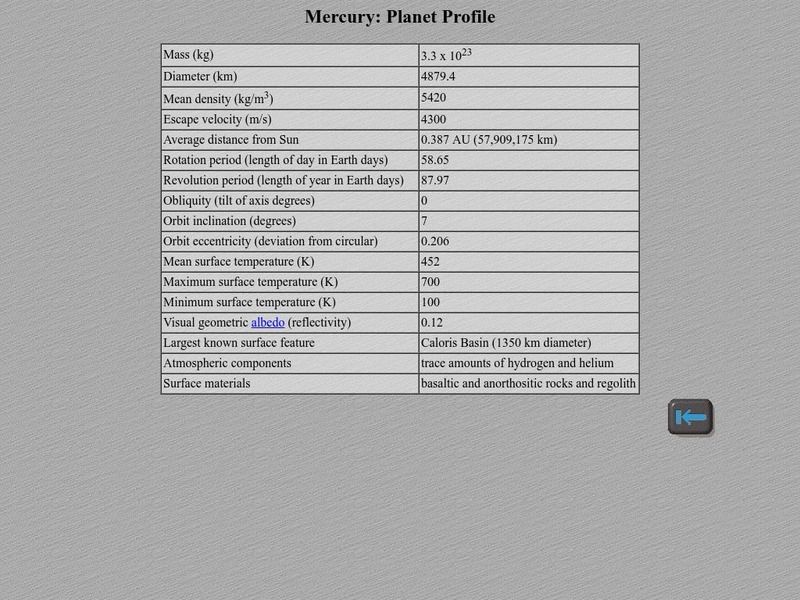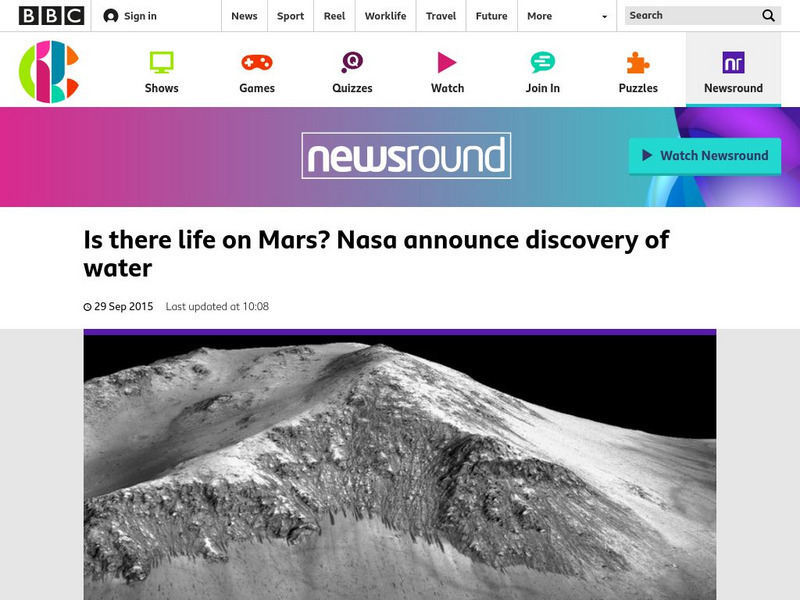NASA
Goddard Education: Eclipse 99
Information is provided about the eclipse of 1999; in addition, facts about elcipses throughout history are also included.
NASA
Nasa Star Child: Earth the Water Planet
Use this site to read about planet Earth. See a photo of the Earth from space, and learn quick facts about the earth's atmosphere, axis, and surface.
NASA
Nasa: Mercury Planet Profile
This page from NASA provides a chart of statistical information on planet Mercury. Its mass, diameter, average temperature, and distance from the Sun are among the characteristics listed.
Curated OER
Nasa: Space Place: Planet Size Comparison
See how all the planets in our solar system compare in size.
Curated OER
Nasa: Space Place: Solar System Comparative Sizes
This picture compares the sizes of the moons of the different planets in the solar system.
NASA
Nasa: Planetary Photojournal: Jupiter
Looking for images of Jupiter or its moons? This is the place to start. Pictures are available from both Voyager missions, Galileo Orbiter and the Hubble Space Telescope. Choose from images of the planet, the ring, any of the Galilean...
TeachEngineering
Teach Engineering: Mission to Mars
The Mission to Mars curricular unit introduces students to Mars-the Red Planet. Students discover why scientists are so interested in studying this mysterious planet. Many interesting facts about Mars are revealed, and the history of...
Exploratorium
Exploratorium: A Guide to Astronomy Resources
A portal to resources on the sun, the Earth's neighboring planets, and the weather in space. Find out why Saturn is the "jewel of the Solar System" and explore what happens when Venus and Mercury make their rare transits across the sun.
PBS
Pbs Learning Media: Epic Earth
This mesmerizing video shows seven views of the earth taken by NASA's camera. Watch the moon cross over the earth, storms in the ocean, and smoke from a wildfire. Included are teaching tips for teachers and background information.
BBC
Bbc Newsround: Is There Life on Mars?
This site provides several reports on NASA's discovery of water on Mars.
Smithsonian Institution
National Museum of Natural History: Ocean Planet: In Search of Giant Squid
An on-line exhibit archived from a Smithsonian exhibit explores and interprets the facts and myths surrounding giant squids - the world's largest invertebrates.
Smithsonian Institution
National Museum of Natural History: Ocean Planet: Water Pollution Toxic Materials
This site, from an archived Smithsonian exhibit, describes and illustrates the effects of toxic materials on wildlife in bodies of water.
Space Telescope Science Institute
Space Telescope Science Institute: Hubble Site
Explore the universe and celestial phenomena made visible by Hubble. High-quality photos of planets, stars, nebulae, and galaxies, complete with individual descriptions, can be viewed online and downloaded for printing and personal use.
NASA
Nasa: Welcome to the Planets Magellan
An overview of the Magellan Mission from the assembly of the spacecraft to its radar mapping of Venus. Includes photographs and descriptions of the different phases of the mission. Streaming audio of the descriptions are also available.
NASA
Nasa: Welcome to the Planets Mariner 10
This web page contains images and information on the Mariner 10 space mission. The information is available in audio format.
NASA
Nasa: Welcome to the Planets Viking 1 & 2
Images and a description of the Viking mission to Mars can be found here. The descriptions are also available in audio format.
NASA
Nasa: Welcome to the Planets Hubble
On this site, you will find information and images pertaining to the primary mirror, launch, and deployment of the Hubble Space Telescope. The information is presented in text and audio format.
NASA
Nasa: Welcome to the Planets Earth
Images of specific locations on the surface of the Earth, taken from space, along with descriptive captions.
NASA
Nasa Star Child: Neptune, the Blue Planet (Level 1)
An introduction to Neptune for young students. Audio content, a glossary, graphics, and a printable version are all included.
NASA
Nasa: Io: Overview: Volcanic Moon
Find out about most volcanically active world in the Solar System, Jupiter's moon named Io.
NASA
Nasa: Deimos: Overview
This site provides statistical information and information on the physical features of Deimos.
Curated OER
Nasa's the Space Place: Solar System: Pluto's Orbit
An illustration showing Pluto's and the other planet's orbits around the sun.
NASA
Astronomical Society of the Pacific: Telescope Treasure Hunt
This hands-on astronomy activity lets learners hunt for different objects in the night sky that contribute to stellar and planetary formation, using a Treasure List. They will learn how stars and their planets form and will find objects...
NASA
Nasa Star Child: The Planet Earth
Facts about the Earth including its orbit, its atmosphere, and its landforms. Includes a discussion question on seasons, with facts about them, and the answer. A linked page covers similar material in a "Level 2" version, and has a...














